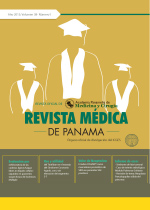Nivel de satisfacción con el tratamiento en pacientes diabéticos tipo 2 internados
Autores/as
DOI:
https://doi.org/10.37980/im.journal.rmdp.2013135Resumen
Objetivo: El objetivo de este trabaja es determinar el nivel de satisfacción con el tratamiento de un grupo de pacientes internados portadores de diabetes tipo 2 . Método: Estudio observacional transversal. Se incluyeron a todos los pacientes mayores de 18 años con diagnostico de Diabetes tipo 2 de al menos un año hasta el presente estudio. Se excluyeron a quienes presentaban patologías atribuibles a la diabetes. Los pacientes debieron responder al ingreso al cuestionario DTSQ. Se analizaron medias, regresión r de Pearson, regresión linear multivariada y prueba de U Mann-Whitney. Resultados: Se incluyeron 102 pacientes. La edad promedio fue de 63.1 años. El valor promedio del DTSQs fue de 14.5. Se observó correlación significativamente estadística entre la puntuación para el cuestionario y los niveles de HbAc1 y glucemia en ayunas entre otros parámetros. Conclusiones: el nivel de satisfacción en pacientes internados con diabetes tipo 2 es menor que el observado en pacientes con igual patología pero provenientes del nivel primario de atención en salud.
Palabras clave: diabetes tipo 2, hemoglobina glicosilada, glucemiaen ayunas, satisfacción.
Abstract
Purpose: The aim of this work is to determine the level of satisfaction with the treatment of a group of in-patients admitted with type 2 diabetes . Method: An observational, cross research was done. We included all patients older than 18 years with type 2 diabetes diagnosed at least one year before the present study. We excluded the patients who had diseases attributable to diabetes. They had to respond to the questionnaire DTSQ. Averages, r Pearson regression, multivariate linear regression and U test Mann-Whitney were analyzed. Results: 102 patients were included. The average age was 63.1 years. The DTSQs average value was 14.5. Statistically significant correlation was observed between the questionnaire and HbAc1 levels, fasting blood glucose and other parameters. Conclusion: The level of inpatient satisfaction in type 2 diabetes is minor than the observed in patients with the same disease, but from the primary level of health care.
Key words: Type 2 Diabetes, fasting glycemia, glycosylated hemoglobin, satisfaction.
Publicado
Número
Sección
Licencia
Derechos autoriales y de reproducibilidad. La Revista Médica de Panama es un ente académico, sin fines de lucro, que forma parte de la Academia Panameña de Medicina y Cirugía. Sus publicaciones son de tipo acceso gratuito de su contenido para uso individual y académico, sin restricción. Los derechos autoriales de cada artículo son retenidos por sus autores. Al Publicar en la Revista, el autor otorga Licencia permanente, exclusiva, e irrevocable a la Sociedad para la edición del manuscrito, y otorga a la empresa editorial, Infomedic International Licencia de uso de distribución, indexación y comercial exclusiva, permanente e irrevocable de su contenido y para la generación de productos y servicios derivados del mismo. En caso que el autor obtenga la licencia CC BY, el artículo y sus derivados son de libre acceso y distribución.






